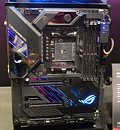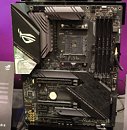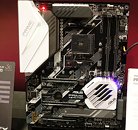Monday, May 27th 2019

ASUS Shows Off its X570 Motherboard Lineup: ITX Included
ASUS at a private pre-Computex event gave us a closer look at a treasure of upcoming products. The star-attractions, however, were its AMD X570 motherboard family that's spread across nearly every brand: ROG Crosshair, ROG Strix, TUF Gaming, Prime, and for the very first time for the AM4 platform, the WS series. The crown jewel of course is the mini-ITX form-factor product, the ROG Strix X570-I Gaming. This board is quite an engineering feat considering the ≥15 Watts TDP of the X570 chipset, which requires active cooling in most cases. An intricate network of heatsinks suspended along heat-pipes leading up to a dense aluminium fin-stack ventilated by a 30 mm fan, cools both the chipset and CPU VRM. ASUS designed this board to handle even the 12-core Ryzen 9 3900X, but we don't expect too much overclocking headroom.The AMD X570 + Ryzen 9 combo promises to eclipse Intel Core i9 + Z390 as the most sought after desktop platform, and ASUS addressed this emerging demand by pulling out its biggest motherboard brands. There are two flagship AM4 products, the ROG Crosshair VIII Formula, and the Pro WS X570 Ace. The ROG Crosshair VIII Formula is for PC enthusiasts seeking to push the Ryzen 9 3900X above and beyond its design limits. 6.00 GHz could emerge as the next frontier for manual overclocking.
This board maxes out connectivity of the X570 platform, and has the most M.2 slots, the strongest CPU VRM, and the most RGB bling. The VRM cooling solution is designed by EK Water Blocks, and can function both dry as a heatsink, or plumbed to your DIY liquid cooling loop. The Pro WS X570 Ace has the most sober design, with zero RGB bling, an all-black design, and the highest quality electrical components for the most durability. There is no iKVM/IPMI remote management hardware, but ASUS is going big with networking, by deploying 10 GbE interfaces.The ROG Strix X570-I Gaming qualifies as a true mini-ITX motherboard and impressed us the most, but there's also the ROG Crosshair VIII Impact. The ROG Impact brand has historically denoted mini-ITX, but this board isn't one, well not strictly. The board sticks out a good 1-inch longer than mini-ITX specifications. The idea behind this being that most mini-ITX gaming cases have room for 2-slot thick graphics cards anyway, so it could make sense to stretch the PCB a little lengthwise, so the precious real-estate gained could be used to cram more devices. This form-factor has been standardized as mini-DTX An elaborate dual-fan cooling solution pulls heat from both the X570 chipset as well as the CPU VRM, which is beefier than the Strix X570-I. You get more M.2 slots, a better onboard audio solution, 802.11ax and 5 GbE connectivity, and a few unique toys such as POST code read-out at the rear-panel.The ATX ROG Strix line includes both a cheaper Strix-F product, and a premium Strix-E product. Both boards appear to be based on a common PCB, with minor variations such as the Strix-E having better VRM components, a meatier heatsink, etc. The mainline Prime series includes two products, the Prime X570-Pro, and Prime X570-P. Both boards are characterized by restrained, sober styling, a feature-set that covers all the essentials, and active fan-heatsinks over the chipset. These are the boards to buy if you intend to run your processor at stock speeds, or with mild CPU overclocking, and don't care much about RGB bling. The TUF Gaming series are variations of these boards, but with TUF Gaming Alliance branding and color-scheme splashed all over the boards. ASUS appears to have made efforts to make its TUF boards look a little less "cheap."
This board maxes out connectivity of the X570 platform, and has the most M.2 slots, the strongest CPU VRM, and the most RGB bling. The VRM cooling solution is designed by EK Water Blocks, and can function both dry as a heatsink, or plumbed to your DIY liquid cooling loop. The Pro WS X570 Ace has the most sober design, with zero RGB bling, an all-black design, and the highest quality electrical components for the most durability. There is no iKVM/IPMI remote management hardware, but ASUS is going big with networking, by deploying 10 GbE interfaces.The ROG Strix X570-I Gaming qualifies as a true mini-ITX motherboard and impressed us the most, but there's also the ROG Crosshair VIII Impact. The ROG Impact brand has historically denoted mini-ITX, but this board isn't one, well not strictly. The board sticks out a good 1-inch longer than mini-ITX specifications. The idea behind this being that most mini-ITX gaming cases have room for 2-slot thick graphics cards anyway, so it could make sense to stretch the PCB a little lengthwise, so the precious real-estate gained could be used to cram more devices. This form-factor has been standardized as mini-DTX An elaborate dual-fan cooling solution pulls heat from both the X570 chipset as well as the CPU VRM, which is beefier than the Strix X570-I. You get more M.2 slots, a better onboard audio solution, 802.11ax and 5 GbE connectivity, and a few unique toys such as POST code read-out at the rear-panel.The ATX ROG Strix line includes both a cheaper Strix-F product, and a premium Strix-E product. Both boards appear to be based on a common PCB, with minor variations such as the Strix-E having better VRM components, a meatier heatsink, etc. The mainline Prime series includes two products, the Prime X570-Pro, and Prime X570-P. Both boards are characterized by restrained, sober styling, a feature-set that covers all the essentials, and active fan-heatsinks over the chipset. These are the boards to buy if you intend to run your processor at stock speeds, or with mild CPU overclocking, and don't care much about RGB bling. The TUF Gaming series are variations of these boards, but with TUF Gaming Alliance branding and color-scheme splashed all over the boards. ASUS appears to have made efforts to make its TUF boards look a little less "cheap."











30 Comments on ASUS Shows Off its X570 Motherboard Lineup: ITX Included
The Formula is weird because the label says Crosshair. So is it Formula or Crosshair Formula?
Hero looks like the best option by having most of Formula features but cheaper.
The lower end boards do not intrest me and there are odd compromises there.
Then I'm interested!
Lets see what the others do, and what the pricing will be :)
Give us a full board waterblock!
But it does not have chipset fan due to one M2 ?
MSI doesn't seem to have any m-atx, Asrock and gigabyte left then.
Else i'm forced to get an Intel, which was not my plan AT ALL!
I think unless you really push the PCIe 4 lanes on the chipset, the fans will probably be off or run at really low rpms (but ideally off).
In my particular case, looking at the X570 diagram, the only thing I'd be using on a regular basis from the chipset is the LAN port. Everything else is coming from the CPU.
I see TPU does have a photo of the board but Anandtech has a photo of the whole board to see.
www.asus.com/Motherboards/RO...-VIII-Formula/
www.asus.com/Motherboards/RO...air-VIII-Hero/
www.asus.com/Motherboards/RO...r-VIII-Impact/
www.asus.com/Motherboards/RO...X570-I-Gaming/
www.asus.com/Motherboards/RO...X570-E-Gaming/
[source]
www.asus.com/Motherboards/ROG-Strix-X570-I-Gaming/